When the internet was born, display ads were the very first form of digital advertising. Back then, they were called banner ads. But they died a slow natural death, mainly because they were super intrusive and irrelevant to web users. To provide some perspective, the CTRs of the first banner ads back in 1994 were 78%. Now the average CTR in the U.S. is 0.8%, half of which are accidental clicks.
However, with better technology, we are now seeing the renaissance of display ads. Companies are spending outrageous amounts of money on them:
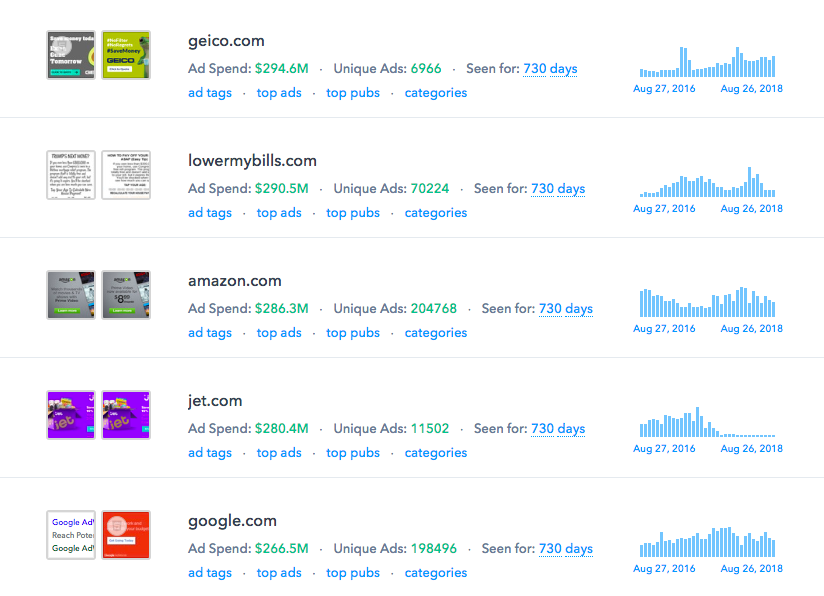
Display advertising has become relevant again as advertisers can now do hyper-targeting based on interests, demography and much more. This has made display ads less intrusive than ever before.
The variety of ads has also gone through a sea change. Today’s advertisers have access to HTML5 interactive ads and video ads in addition to the usual image ads. But with so many possibilities, it can get a bit confusing. This Guide is designed to make things simple and actionable for you!
What is display advertising?
Display advertising can be defined as a type of advertising that’s seen on publishing sites and is separated from the editorial content. Advertisers have the option of using images, videos or graphics to entice people into clicking the ad.
Display ads can blend in seamlessly with the design and style of a website, which is why they’re commonly used by publishers, such as the New York Times.
In the example below, an ad for Grammarly appears directly below a row of news stories on the New York Times’ homepage—much in the same way a print ad might appear in the Sunday paper.

Display ads are more powerful than print ads, of course, because they’re digital. This ad is not just programmatically generated based on the viewer’s browsing and search history, but it also includes a customizable CTA that the advertiser can set and an external landing page that the CTA will take users to.
Display ads can be a powerful means of lead generation for a product, a way to bring bounced users back to your site or get prospective customers into your conversion funnel or simply a means of increasing brand awareness among the demographic that you’re targeting.
McAfee AntiVirus uses two different landing pages for branding and conversions.
For example, this is the header of the landing page used for branding purposes:

As you can see, the main intention of this page is to get users to watch their branding video, which talks about how they’re changing the world one client at a time.
This is how their conversion-focused landing page looks:
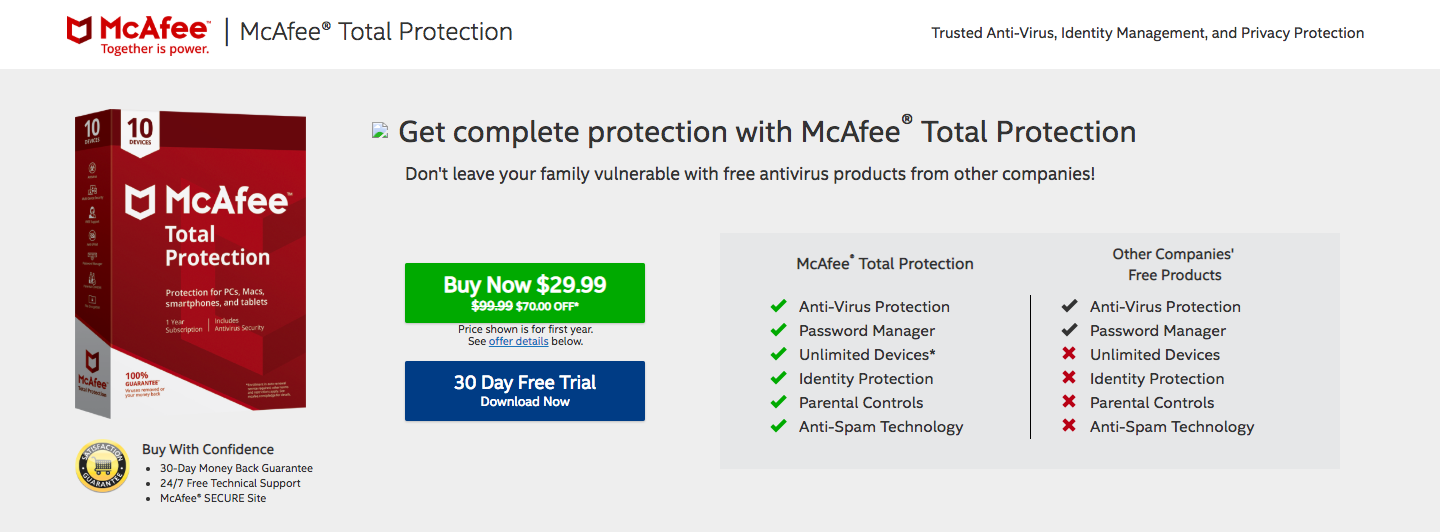
There are clear CTAs to get the user to at least try the free trial. The copy on the page is clearly intended to push for direct sales.
What are the different types of display ads?
Text Ads
Text ads generally consist of a headline, at least 20 words of body text, and a link to the advertiser’s landing page.
Since they take up less screen real estate and offer no multi-media, text ads are generally the least expensive type of display ad you are able to purchase, so they’re great if you have a limited advertising budget. They’re usually also quicker to produce, since less creative work is required—though you still shouldn’t skimp on the effort when crafting your ad’s headline and body text.
Some publishers do primarily serve text-based display ads to their visitors because it’s often easier to make a batch of text blend in with the content around it than it is to make a video or large graphic blend in. So if you’re looking to reach a specific site’s visitors, it’s worth checking whether they show text-based display ads.

At the same time, however, without the ability to add rich elements like images, text ads aren’t going to build a strong sense of brand awareness among the people who see them.
Ultimately, text ads are best for targeted placements among users with high-intent. Say someone searches “new york city plumber” and then stumbles upon a text ad with your phone number and hours of operation right in it—that’s the kind of targeted intent that you want to capture with text ads rather than any broad-based kind of brand awareness play.
Image Ads
Image-based ads come in all shapes and sizes. The possible size is generally determined by publishers and ad networks. The Google Display Network allows a wide variety of sizes:
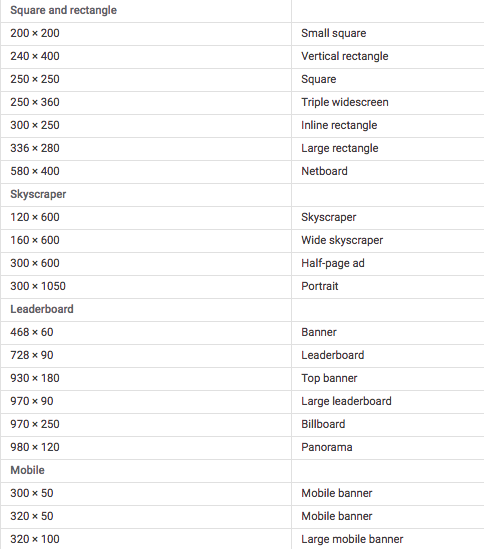
We analyzed 40,000 high-performing image ads (creatives with an ad spend of more than $3,000) to see if there’s any relation between image size and success. We found an amazing correlation. You can check out the entire study here.
Image ads are much more effective than text ads. Humans are visual beings. Our minds are designed to process images 60,000 times faster than text. Moreover, you can use your brand colors and logo, which in turn reinforces your brand image in the mind of the visitor. It gives you a whole new dimension in terms of creativity.
Also, compared to HTML5 and video-based ads, image ads are easier and less expensive to create. Testing also becomes a simpler process as it’s easy to create multiple versions of the same ad in different sizes.
All these factors make image ads the most-used type of display ads. Ironically that is the only problem; everyone is using it! Many brands are moving towards HTML5 ads to stand out and garner attention.
Image ads are used for mass awareness campaigns. The idea is to familiarize your audience with your brand. If you are super-focused on clicks rather than impressions and if you have a good ad budget, it is better to create HTML5 ads.
HTML5 Ads
HTML5 ads are essentially mini web pages and require lots of back-end coding. However, it’s one of the most interactive and attention-capturing ad formats you can use. It’s easy to catch the attention of people as it will be the only moving content on the whole page.
The possible sizes in the Google Display Network are the same as that of image ads.
One of the best advantages of HTML5 ads is that it can be made non-intrusive. Undertone did a really cool ad for MLS:
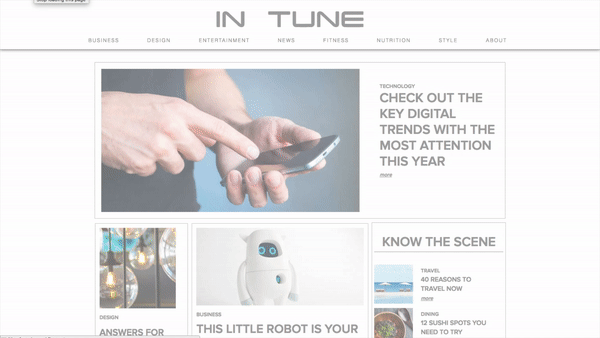
The entry is a bit flashy but many wouldn’t find it intrusive. In fact, it looks pretty cool and arouses curiosity. Then it suddenly goes away in a flash and settles at the side. At this position, the ad is fully viewable but far from intrusive as it’s neatly packed on the side.
There are so many creative ways to improvise HTML5 ads. For example, NordicBet uses it to gamify the whole experience:

Match.com makes their HTML5 ad look like a part of the publisher’s website:
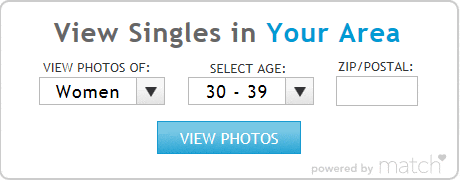
The sky is the limit with HTML5 ads. It is also much more effective than static image ads in many cases if done well. A recent study by Aarki saw an increase of 86.48% in ROI by replacing a static ad with a similar HTML5 variant.
The only problems with HTML5 ads are the costs involved, which can go up to hundreds of dollars.
Video Ads
Video ads are videos that play automatically when a visitor enters a publisher’s page. The video is usually muted and the volume can be turned on by clicking the volume button in the player.
This video ad in Forbes uses subtitles so that people understand what’s going on even without volume:

The problem with such ads on publications is that the context is a bit less. Many people come to such websites to read and find popup videos annoying.
How to find the right publishers (direct buy vs. ad networks)
There are two ways to approach publishers. The obvious way is to get in contact with them directly. However, many prefer to buy display ads through middlemen called ad networks.
This is because, when you buy direct, you have to buy in bulk, and this can often be expensive. For example, Forbes has set a minimum limit of $500:
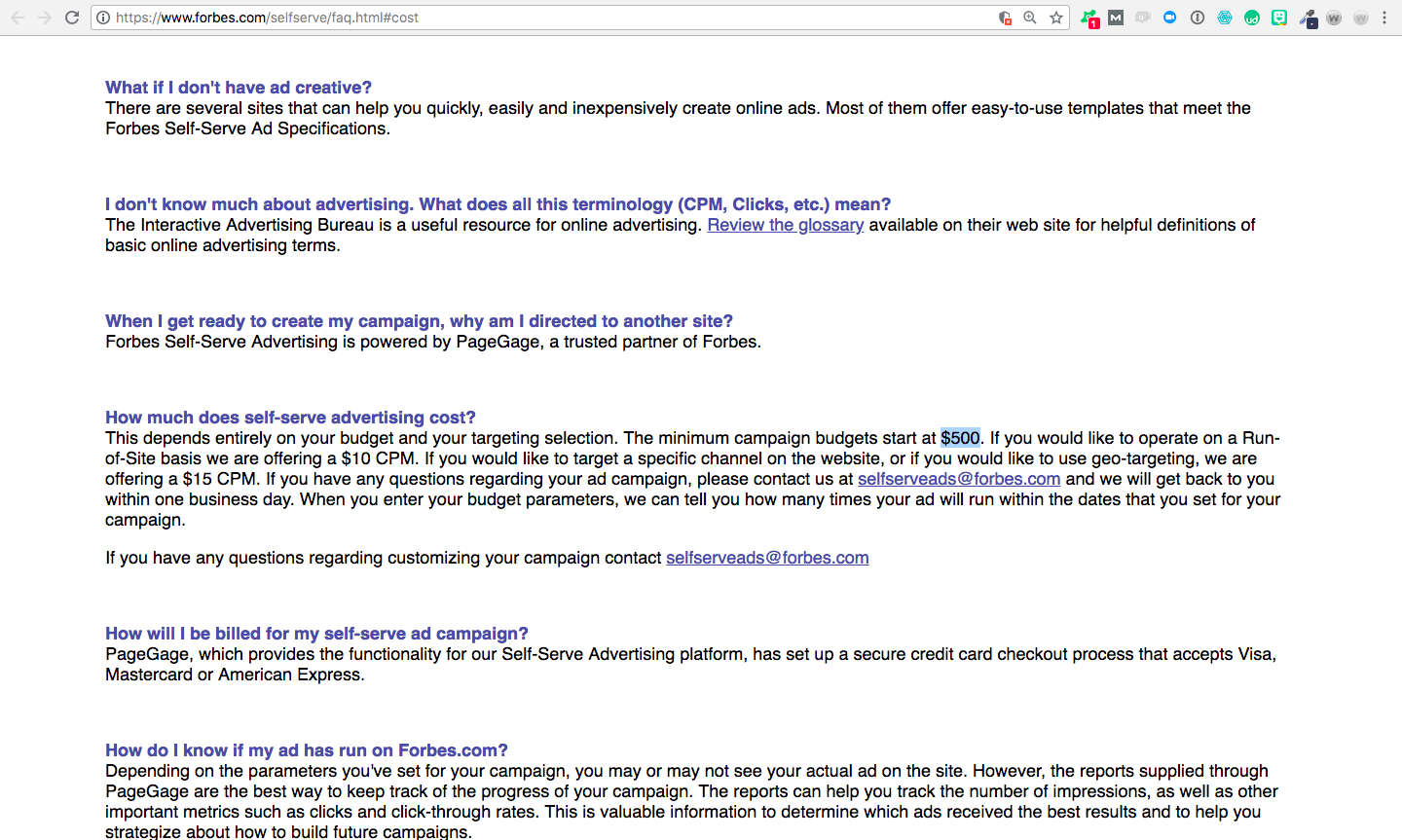
When it comes to direct dealings, sometimes you’ll be able to negotiate; sometimes you won’t.
So why do some advertisers choose to go for direct buys?
The advantage is that you can get preference over other advertisers that come via ad networks. Also, the publishers will have a dedicated team that works with you to ensure the best results.
Ad networks, on the other hand, are great if you don’t have a large ad budget. You can try it out and see what works, and, at the same time, you also get access to a huge number of publishers.
While there are many ad networks out there, the Google Display Network is the most popular. The best way to choose the right publishers is by finding out what your competitors are doing. You can use competitive analysis tools to get in-depth stats on what works for your industry.
What are the different ways to target your ads?
Apart from the ad creative, one major aspect influencing the success of your ad campaign is the targeting. Here we’ve chosen the targeting options provided by the Google Display Network as it’s the most popular ad network:
Contextual targeting: With contextual targeting, you advertise on websites that have content similar to your product. For example, advertising your soccer balls on a soccer news channel is contextual targeting. Here the data about the visitor is not taken into consideration. And it’s not just on the internet; almost all ads in print media are examples of contextual targeting.
Demographic targeting: The demography of your ideal target audience consists of gender, age, location, marital status, education and much more. This type of targeting is suitable only if any of these traits are common to all your customers.
Psychographic targeting: Psychographics refers to a person’s interests, likes and dislikes. This can be anything from political perspectives to hobbies. If your customers have common interests, this type of targeting can be way more accurate than contextual targeting.
Remarketing: Remarketing is all about targeting people who’ve already been exposed to your brand. This can be done by adding certain tags onto your own website so that Google tracks these users. However, due to GDPR, this type of targeting is losing ground.
Placement targeting: This allows you to place your ad in places where you will get maximum attention. You can even choose the exact page you think will be most relevant.
Here is a detailed guide on how to target efficiently.
Display advertising KPIs: The art of analyzing your ad campaigns
Once you start running your campaigns, you have to keep your eye on certain important metrics:
- CTR (Click-Through Rate): This is the number of people clicking on your ads. It’s the basic benchmark to check if your ads are effective. If the CTR is poor, this could be due to two reasons—either your ad copy and image are not good enough, or your targeting is poor.
- Bounce Rate: If a visitor comes to your site and exits without clicking on any links, it is considered a bounce. In this context, bounce rate refers to the percentage of people bouncing off your landing page after clicking your ad. A high bounce rate would suggest that people did not see what they were expecting. You can try testing different landing page copy and visuals to see what works best.
- Conversion Rate: Conversion rate is the percentage of people who completed your goal. The goal can be anything from buying your service to registering for your weekly newsletter.
- ROI (Return on Investment): This is probably the most important metric of all. Return on investment is an attempt to quantify the amount your business made as a result of your ad campaign. If the ROI is less than your total ad budget, you have some serious changes to make.
Here is a detailed guide on how to analyze your display ad campaign in the Google Network.
Once you do the analysis, you might find that you’re not getting traffic or conversions. Here’s a step-by-step guide on how to fix your traffic and conversion problems.
Display advertising tactics
From copywriting to creative design, there are a lot of individual skills that are involved when crafting a great display advertising campaign.
We’ve written several pieces on the Adbeat blog focusing on various tactics that you can use to get more customers and spend less—while getting more:
- Write Higher Converting Display Ads With These 8 Formulas: The ad copy is one of the most instrumental aspects of an ad that drives CTRs. But does this mean you have to spend thousands of dollars on professional copywriters? Not if you read this post.
- Display Advertising: It’s Not All About Banners and Visuals: Many advertisers put all their effort in the ad creatives and forget the many other aspects of display advertising that make a huge difference. Read this post to not fall into the same pit.
- How To Sell Enterprise Software With Display Advertising: This post is for our B2B advertising friends who are trying to find a way to grow using display ads. Lots of hidden tactics in here!
- The Power of Celebrity in Display Advertising (Donald Trump Edition): Getting celebrities in your advertisements is a million dollar game. But there is a way to use their name and fame to get your ads clicked without paying them any endorsements.
Display advertising examples
Display advertising is a multi-billion dollar industry. As a lot of money is being spent, there are many case studies that can guide you in your own campaigns.
We’ve been doing a popular series called “The Business of Display,” which looks into a particular industry every week. We’ve released many such posts so far:
- The Business of Display Part 1: Niche Viral Sites: Here we look into the ad strategies of Digital Trends, InsideGov and History Fanatic.
- The Business of Display Part 2: Viral Quiz Sites & Click Arbitrage: Here we look into the ad strategies of Playbuzz, Buzztroopers and Quizfactory.
- The Business of Display Part 3: Nutraceuticals: An insight into how nutraceuticals use display advertising to gain profits.
- The Business of Display Part 4: Information Products: A complete analysis of how information can be sold as a product. This includes everything from its sales funnel to its display ad strategies. Also includes a case study of Old School New Body.
- The Business of Display Part 5: Affiliate Review Sites: Analysis of how affiliate review sites use display advertising to get more conversions. Also includes case studies of NextAdvisor and Total Beauty.
- The Business of Display Part 6: Lead Generation for Contractors: Breaks down the lead generation sales funnel of contractors.
- The Business of Display Part 7: Making Money with Coupons: A complete insight into how coupon websites work and how display advertising fits into their overall strategy. Case studies of the top five coupon websites have also been done.
- The Business of Display Part 8: Credit Card Affiliate Offers: A complete overview of how credit card affiliate systems work and an in-depth analysis of how they use display advertising.
- Advertising Strategies from the Billion Dollar Business of Meal Kit Delivery: How top meal kit delivery companies use display ads to rake in tons of profit. A complete breakdown of their ad networks, publishers, ad creatives and even landing pages has been done.
- How WebMD (and Others) Use Display Ads to Make $10m+ in Ad Revenue: The first thing that people do when they get sick these days is to Google their symptoms, even before meeting the doctor. While most ailments lead to cancer, according to online health publications, these guys are making millions of dollars in ad revenue. This post is a sneak peek into their ad revenue.
Display advertising case studies
There’s no better way to learn about how to run a display advertising campaign and get inspired than to learn from the best.
That’s why we’ve taken some of the most successful companies out there that have used display advertising and taken apart their strategies, tactics, spending and ad types to help you improve.
- 0 to 1 Million Customers in 3 Months: Jet’s Display Strategy Revealed: Just two years after their official launch, Jet was acquired by Walmart for $2 billion. Walmart’s main aim was to take on Amazon. But why did they choose Jet? It all comes down to their amazing growth story. Jet hit 1 million users in less than 3 months from their launch! In this piece, we take apart all of the ad networks, publishers, ad creatives and landing pages that Jet used on its road to success.
- How Walmart and Target Use Display Advertising: Big box stores are large retail stores that sell almost everything, from diapers to TV remotes. These companies are well-known for splashing tons of money on television commercials and billboards. But what is their display ad strategy like? In this post we unravel the mysteries!
- An Uncensored Peek Inside Grammarly’s $2.2M Display Strategy: Grammarly’s growth story is probably one of the most phenomenal of all. Today they have 6.9 million daily users, many of which were gained through a sound display strategy. In this post, we study their ad networks, publishers, ad creatives and even landing pages!
All these insights were gained via our competitive intelligence tool. If your industry is missing here, feel free to check out the tool yourself!
Trackbacks/Pingbacks